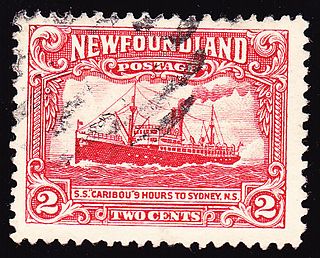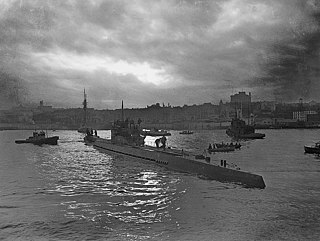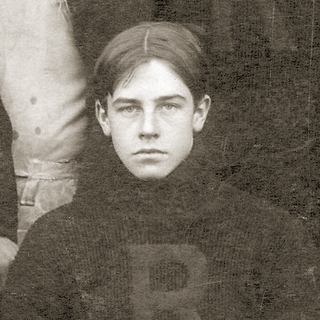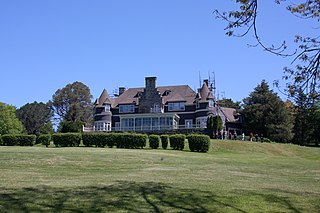Bras d'Or Lake , the name of which means arms of gold or golden arms, is a saltwater lake on Cape Breton Island.
Bras d'Or can also refer to:

Cape Breton Island is an island on the Atlantic coast of North America and part of the province of Nova Scotia, Canada.

Baddeck is a village in northeastern Nova Scotia, Canada. It is situated in the centre of Cape Breton, where the Baddeck River empties into Bras d'Or Lake.
Bras d'Or Lake is an irregular estuary in the centre of Cape Breton Island in Nova Scotia, Canada. It has a connection to the open sea, and is tidal. It also has inflows of fresh water from rivers, making the brackish water a very productive natural habitat. It was designated the Bras d'Or Lake Biosphere Reserve by UNESCO in 2011.
Canso may refer to:

Canadian Forces Base (CFB) Halifax is Canada's east coast naval base and home port to the Royal Canadian Navy Atlantic fleet, known as Canadian Fleet Atlantic (CANFLTLANT), that forms part of the formation Maritime Forces Atlantic (MARLANT).

SS Caribou was a Newfoundland Railway passenger ferry that ran between Port aux Basques, in the Dominion of Newfoundland, and North Sydney, Nova Scotia between 1928 and 1942. During the Battle of the St. Lawrence the ferry participated in thrice-weekly convoys between Nova Scotia and Newfoundland. A German submarine attacked the convoy on 14 October 1942 and Caribou was sunk. She had women and children on board, and many of them were among the 137 who died. Her sinking, and large death toll, made it clear that the war had really arrived on Canada's and Newfoundland's home front. Her sinking is cited by many historians as the most significant sinking in Canadian-controlled waters during the Second World War.

The Battle of the St. Lawrence involved marine and anti-submarine actions throughout the lower St. Lawrence River and the entire Gulf of Saint Lawrence, Strait of Belle Isle, Anticosti Island and Cabot Strait from May–October 1942, September 1943, and again in October–November 1944. During this time, German U-boats sank over 20 merchant ships and four Canadian warships. There were several near-shore actions involving the drop of German spies, or the attempted pickup of escaping prisoners of war. Despite the 23 ships lost, this battle marked a strategic victory for Canadian forces as ultimately they managed to disrupt U-boat activity, protect Canadian and Allied convoys, and intercept all attempted shore operations. This marked the first time that a foreign power had inflicted casualties in Canadian inland waters since the US incursions in the War of 1812.

HMCS Bras d'Or was a hydrofoil that served in the Canadian Forces from 1968 to 1971. During sea trials in 1969, the vessel exceeded 63 knots, making her the fastest unarmed warship in the world at the time.

Frederick Walker Baldwin, also known as Casey Baldwin, paternal grandson of Canadian reform leader Robert Baldwin, was a hydrofoil and aviation pioneer and partner of the famous inventor Alexander Graham Bell. He was manager of Graham Bell Laboratories from 1909–32, and represented Victoria in the Nova Scotia Legislature from 1933–37, where he was instrumental in bringing about the creation of Cape Breton Highlands National Park. In 1908, he became the first Canadian and British subject to fly an airplane.
The Royal Canadian Navy uses hull classification symbols to identify the types of its ships, which are similar to the United States Navy's hull classification symbol system. The Royal Navy and some European and Commonwealth navies use a somewhat analogous system of pennant numbers.

Beinn Bhreagh is the name of the former estate of Alexander Graham Bell, in Victoria County, Nova Scotia. It refers to a peninsula jutting into Cape Breton Island's scenic Bras d'Or Lake approximately 3 km (1.9 mi) southeast of the village of Baddeck, forming the southeastern shore of Baddeck Bay.
Bras d'Or (R-103) was a small experimental hydrofoil built for the Royal Canadian Navy (RCN) during the 1950s. It led to the development of HMCS Bras d'Or (FHE 400) in the late 1960s.

HMCS Cape Breton was a River-class frigate that served the Royal Canadian Navy (RCN) during the Second World War. She served primarily as a convoy escort in the Battle of the Atlantic during the war. She was named for Cape Breton Island in Nova Scotia. She was the first to carry her name, HMCS Cape Breton was the second.
HMCS Bras d'Or is a name used by the Royal Canadian Navy and Canadian Forces MARCOM for several ships, named after Bras d'Or Lake.
Baddeck, Nova Scotia is a village founded in 1908, with a history stretching back to early Mi'kmaq, French and British settlements. The village was home to Alexander Graham Bell and was witness to the first flight in the commonwealth with Bell's Silver Dart.

HD-4 or Hydrodome number 4 was an early research hydrofoil watercraft developed by the scientist Alexander Graham Bell. It was designed and built at the Bell Boatyard on Bell's Beinn Bhreagh estate near Baddeck, Nova Scotia. In 1919, it set a world marine speed record of 70.86 miles per hour (114.04 km/h).
HMCS Bras d'Or was an auxiliary minesweeper that served in the Royal Canadian Navy (RCN) between 1939 and 1940, when she sank with all hands in a storm. Previous to her service in the RCN, she served as Lightship No. 25 in the Canadian Department of Marine and Fisheries.
HMCS Quinte was a Bangor-class minesweeper constructed for the Royal Canadian Navy during the Second World War. The ship entered service in 1941 and took part in the Battle of the Atlantic. On 30 November 1942, Quinte ran aground and sank off Cape Breton Island. The ship was re-floated and repaired and spent the rest of the war as a training ship. Following the war, the minesweeper was used for naval research until decommissioned in 1946. The vessel was sold for scrap and broken up in 1947.

The Experimental Craft Hydrofoil No. 4 (XCH-4) was a high speed hydrofoil of the United States Navy. In 1947 the Bureau of Ships in association with the Office of Naval Research subsidised the construction of a number of small watercraft to explore several different types of foils and foil control-system configurations. The XCH-4 was designed by John H. Carl and built, in 1953, by Dynamic Developments Inc., a former associate of the Grumman Aircraft Engineering Corporation.

The Llewellyn-class minesweepers were a series of ten coastal minesweepers constructed for the Royal Canadian Navy during the Second World War. Based on the Admiralty type MMS-class minesweeper, the Llewellyn class were constructed of wood and used for the removal of magnetic influence mines. Two were built in Quebec, with the eight constructed on the Western Coast of Canada. Mostly used as guard ships during the war, only three of the ten remained in Royal Canadian Navy service following the war, with the last being discarded in 1957. Following naval service, vessels of the class ended up in commercial service, with some becoming fishing vessels, cargo ships and one a floating restaurant. Six of the ten ships were lost in commercial service.